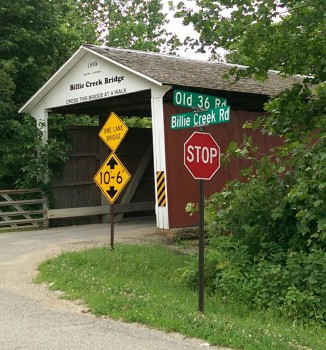Indiana at 200 — Indiana’s Covered Bridges
By ANDREA NEAL
 Like an heirloom jewel passed down through generations, covered bridges are Hoosiers’ most threatened inheritance.
Like an heirloom jewel passed down through generations, covered bridges are Hoosiers’ most threatened inheritance.
From 1835 through the 1920s, more than 600 covered bridges were built in Indiana. “Only 89 are still standing today,” according to the Indiana Covered Bridge Society, which works to preserve and restore them.
Of those, some still carry traffic, others have been bypassed or relocated and five are on private property.
Indiana lost most of its covered bridges before communities realized they were worth saving. They were blown down, burned down, torn down or replaced by newer structures made with steel and concrete.
Starting in the 1970s, preservationists worked to get surviving bridges on the National Register of Historic Places, giving them a degree of protection from intentional demolition. Like anything fragile, they are still vulnerable — to fire, floods, vandalism and bad driving.
![]() The first covered bridge in the United States was built over the Schuylkill River at Philadelphia by the famed New England bridge-builder Timothy Palmer. It was dubbed the Schuylkill Permanent Bridge because, up to that time, folks wanting to cross the river had to take a ferry or use a floating pontoon bridge.
The first covered bridge in the United States was built over the Schuylkill River at Philadelphia by the famed New England bridge-builder Timothy Palmer. It was dubbed the Schuylkill Permanent Bridge because, up to that time, folks wanting to cross the river had to take a ferry or use a floating pontoon bridge.
Its completion in 1805 ignited a covered-bridge building craze. “Immediately wooden bridges all over America added coverings, and new bridges planned were thenceforth designed as covered bridges,” said historian Eric Sloane in the American Geographical Society’s July 1959 journal.
The building of the National Road through the middle of the state launched Indiana’s covered-bridge era, with the first one erected in Henry County in 1835, according to the Indiana Historical Bureau.
Two of the top builders were J.J. Daniels and Joseph A. Britton who lived near Rockville, explaining the concentration of covered bridges in Parke County, which calls itself “Covered Bridge Capital of the World.” Starting the second Friday in October, Parke County hosts an annual 10-day festival with special tours of its 31 bridges — the most of any Indiana county.

Cars still traverse the 62-foot Billie Creek Bridge over Williams Creek in Parke County, built in 1895 by J.J. Daniels.
Why were bridges covered? “To keep them dry,” explains Karin Woodson, curator at the Parke County Historical Society Museum. Wood rots rapidly when exposed to rain and snow. Covering bridges kept moisture out of the joints, prevented sagging boards and protected the floors from becoming slippery.
A friendly competition between Indiana’s Medora Covered Bridge and the Cornish Windsor Covered Bridge in New England has yet to determine which is the nation’s longest.
Medora, which crosses White River’s east fork in Jackson County, claims to be longer with a clear span of 430.4 feet. That is the length of the bridge between abutments. The bridge was built in 1875 and closed to vehicles in 1972. The Cornish Windsor, which crosses the Connecticut River between New Hampshire and Vermont, claims to be longer at 449.5 feet based on the length of its lattice truss, which extends past the abutments. It is two lanes and still open to car traffic.
Bridgeton in Parke County claims to have the state’s “most famous covered bridge” because it crosses a waterfall. The 267-foot bridge, once the most photographed bridge in the state, was destroyed by arson in 2005. Citizens came together and built a replica the following year that is almost identical to the original built in 1868 by J.J. Daniels.
Directions: The Billie Creek Bridge is at the intersection of Billie Creek Road and Old State Road 36 just east of Rockville.
EDITORS NOTE: This is a series of essays leading up to the celebration of the Indiana Bicentennial In December 2016. The essays focus on the top 100 events, ideas and historical figures of Indiana, in chronological order, tying each to a place or current event in Indiana that continues to tell the story of the state.
Andrea Neal is a teacher at St. Richard’s Episcopal School in Indianapolis and adjunct scholar with the Indiana Policy Review Foundation. She has written extensively about taxes, good governance, higher education, civic education and K-12 reform. Contact her at [email protected].
Indiana Policy Review Foundation is a non-profit education foundation focused on state and municipal issues.
